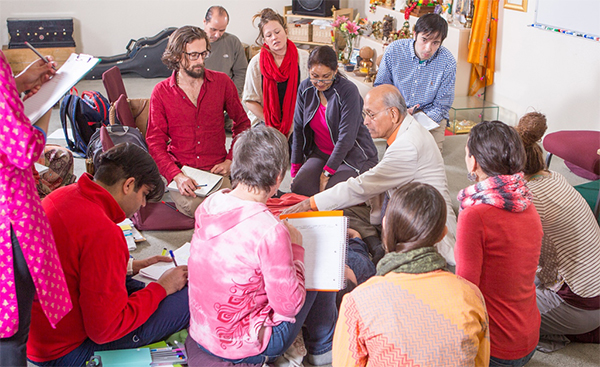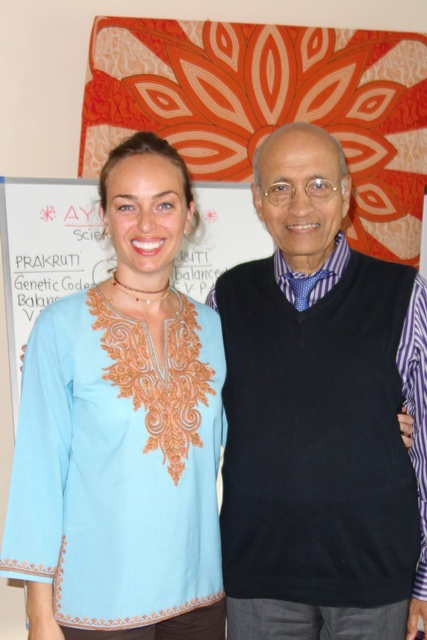
4. How do you divide your time between US and India? In other words, how long do you stay at the Vasanta Institute of Ayurveda near Pune and how long at the Ayurvedic Institute in Albuquerque?
I am in the USA from January to mid-July. Then I travel to New York and Germany, and then to India.
I spend the fall season in India, with travel to Europe for a short time in October. So on average, I am in the USA for seven months and in India for the other five months.
We have multiple programs in India each year: a panchakarma therapist program (PK), two six- week programs in August and September, and our advanced study Gurukula (GK) program for six weeks in November and December. In the PK program, the students can learn how to perform the important panchakarma therapies. Our GK program is an advanced program for students who have finished the Ayurvedic Studies Programs, Levels 1 and 2 at the Ayurvedic Institute and wish to have more exposure to clinical practice.

5. What do you envisage as the average length of study in order to become a real Ayurvedic doctor? Is it true that one needs to study for nine years in India to become an Ayurvedic surgeon?
In India, the real Ayurvedic course is a BAMS, which is a Bachelor in Ayurvedic Medicine and Surgery.
That course is four and a half years long, plus an internship of one year, which makes five and a half years. In order to become a Master of Ayurvedic Science (MASc), which is like an MD, or an Ayurvedic Surgeon, one must complete the BAMS protocol, then study an additional three years to become a Surgeon or Ayurvedic MD.
For the MASc, students are taught under guidance and they write a thesis on a clinical subject. For instance, it might be on the role of shatavari in endometriosis, the role of pippali in treating asthma or cystic fibrosis, or the role of neem in managing skin diseases. When the case studies are approved, that student is allowed to go for his or her examination. There are additional exams: a return examination, a theory examination, a practical examination, and a clinical examination. Then the person becomes a fully qualified Ayurvedic MD or Ayurvedic Surgeon.
6. So that is nearly nine years of study. How does Ayurveda view fatal diseases such as cancer? What is the treatment process for such a disease? Is cancer preventable? Can Ayurveda medicine treat cancer?
Cancer is a tri-doshic disorder, vata pushing pitta pushing kapha.
Cancer also has a genetic predisposition. When a patient is diagnosed in the earlier stages, there are Ayurvedic rasa shastra compounds that can help. When indicated, the patient can do the panchakarma detoxification program. Just like cancer treatment in modern medicine, Ayurvedic treatment involves team work. And just like in modern medicine, early diagnosis and treatment yields better results. Once cancer has metastasized (spread) it is more complicated.
7. I attended your class in Istanbul on breathing techniques. What is the secret of breathing techniques and how do they establish such a profound and rapid balance on the human body? Is there a message you would like to share with us regarding the breathing techniques?
These breathing techniques are called pranayama.
In one technique, Anuloma Viloma (alternate nostril breathing), we create balance between right nostril breathing and the right breath cycle and left nostril breathing and the left breath cycle. The right cycle is relates to the right sympathetic trunk. It is connected to the pingala nadi, which provokes pitta. Left nostril breathing is connected to ida nadi, it provokes kapha. Between the two is vata. So just by doing alternate nostril breathing, pranayama, we balance the three doshas: kapha, pitta, and vata. Once the doshas are balanced, then one’s samprapti, pathogenesis, can be reversed. That is why pranayama is the top ancient technique. When the doshas leave the gastrointestinal (GI) tract and deposit the dosha into the deep tissues, it is pranayama that can bring them back into the GI tract, like panchakarma. When the doshas are stuck in the deep connective tissue, they create pathophysiological changes. Just by doing pranayama, they can be healed. It is like pranic panchakarma.
Here is a profound breathing technique. Simply, you sit quietly. Consciously breathe in and deeply breathe out for first ten minutes. Breathe in and breathe out. Apply your whole bodily energy to this breathing. Sit quietly and go on doing gentle, deep profound breathing. Within 10 minutes, you will separate a little from the body. First, whatever grief, sorrow, or sadness you have, it will come out. Whatever hurt or trauma is in you will come out. Your body may feel like crying, so cry out. Your body may want to do certain mudras, postures or gestures, let it do them. In the second stage of breathing, continue witnessing and allow the body to move, to perform its postures. In that way, breathing is a re-birthing. You are re-born. Just by watching the breathing, you enter the third stage where you move fully into witnessing. Witness the body, witness the mind. Then suddenly you will enter into a vast space of light; that light is God.
Breath is the bridge between body, mind and consciousness. That is why if we do pranayama. We are cleansing the body, mind and consciousness. When the body, mind and consciousness are in harmony, your consciousness is clean. It becomes transparent, translucent and you can see your own light. Be a light to yourself. It happens through breathing. The active principle of any medicine is prana, and the ultimate medicine is prana, the breath. With breathing, we can cure any disease.
Continue